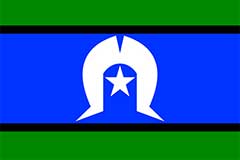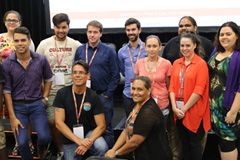
On 15 September in the year 2000, the world was captured by the Opening Ceremony of the Olympic Games held in Sydney, Australia. It was a tribute to Australia’s culture, history and identity.
The ceremony concluded with former Australian Olympic champion Herb Elliott bringing the Olympic Flame into the stadium. The crowd cheered as it was passed through the hands of other former Australian Olympic champions and then quietened in anticipation of who was to light the stadium’s Olympic torch. Finally, it was revealed Cathy Freeman, Australia’s athletic darling at the time, had the honour of lighting the stadium’s Olympic flame in the cauldron within a circle of fire. This was an emotional moment for the nation symbolising the Australian people’s desire to reconcile with the Aboriginal and Torres Strait Islander peoples.
Ten days later, Cathy continued to capture the nation's and the world’s heart when she won the gold medal in the 400 metre sprint. During her victory lap she carried both the Australian and Aboriginal flags — a true symbol of reconciliation and pride of her Aboriginal cultural heritage.
Cathy Freeman was the first Aboriginal person to win gold in an individual event at the Olympic Games. To this day, Cathy continues to be an inspiration to all Australians.
Early life
Cathy was born in Mackay, Queensland on 16 February 1973, three hours from her extended family who lived at Woorabinda, an Aboriginal mission. She moved around with her family living in Hugehendan, describing it as a �?dry and dusty coal-mining town’, 500 kilometres west of Mackay, to Kooralbyn, on the outskirts of Beaudesert in South East Queensland.
Cathy became involved in athletics at a very young age and from her first race at eight years old, Cathy claims that she was �?hooked’ on running. One of Cathy’s primary teachers, Mrs Bauldry, raised money for Cathy to attend the state primary school championships and bought her a pair of running spikes. Mrs Bauldry’s encouragement made Cathy aware of the “excitement (her) running generated among adults.” As she grew older, her passion for athletics came to dominate her thoughts and life:
The dream evolved throughout my childhood and by the time I was at high-school I wasn’t thinking about anything else. The first thing I remember about running is how happy it made me feel.
At fourteen, Cathy told her vocational officer that her only career goal was to win an Olympic medal. By then, she had already won national titles in high jump, the 100, 200 and 400 metre sprints. She won her first gold medal in the 4 x 100 metre relay at the 1990 Commonwealth Games when just sixteen years old.
In 1986, Cathy received a scholarship to board at Fairholme College. Cathy was out of place and homesick at Fairholme College, which only had a few Aboriginal students, was governed by strict routines and rules for dress and conduct, and attracted ambitious, wealthy young women. Cathy reflected on her first impressions of Fairholme College in her autobiography, Her Own Story:
"What was a little black girl doing in a place like this? For a young Aboriginal girl used to the laidback lifestyle of tropical Mackay, it was a major culture shock…. It was like boot camp."
Cathy had never found it easy to apply herself to her studies, and her performance declined at Fairholme College. She felt alienated and tended to daydream about Mackay. In 1989, she was held back a year because her marks were too low.
Some of the girls actually thought I was slow. While it was true that my heart wasn’t in the classroom, I was disappointed that the teachers didn’t support me more. It seemed to me that they didn’t attempt to understand how it felt to be the only black girl in the class...I was too shy and scared to put up my hand and ask a question if I didn’t know what was going on. I didn’t want to bring any attention to myself; that was the way I had been raised.
Years later, when Cathy spoke at the Melbourne Olympic bid in Tokyo in 1990, she found herself thinking “If only the Fairholme girls could see me now.” Despite these bitter emotions, Cathy felt she benefited from her time at Fairholme College, and was reluctant to leave for Kooralbyn International School.
The place that had given me so much hell had actually grown on me. After eighteen months there, I was much more confident in myself and had learnt a lot about the world from the students and teachers.
Career takes off
Cathy was employed as part of Australia Post’s Olympic Job Opportunities Program in 1992.
Being part of the workforce was a lot of fun and having a normal life really appealed to me. Somehow I knew that if my running took me to where I wanted to go, I wouldn’t have a normal life for much longer.
That year, Cathy also started to receive sponsorship for her athletics, first from leading Aboriginal business, Balarinji Design studio, then Oakley and Nike and later Qantas, Schweppes, Telstra, Ford, Australia, News Ltd and Channel 7.
After the 1994 Commonwealth Games, Cathy continued to work for Australia Post moving into the public relationship department. However, as her training became increasingly “full on”, and her sponsorship increased, Cathy phased out other forms of employment.
Throughout her athletic career, Cathy received numerous awards including the Olympic Order for Sportswoman of the Year in 2001, and was named Australian of the Year in 1998.
After retirement from running
Following her retirement in 2003, Cathy pursued interests important to her especially those related to Aboriginal and Torres Strait Islander people. She has been involved with a number of charities and community activities including Cottage by the Sea — one of Australia’s oldest charities providing seaside respite care to children.
In 2006, she took part in a television series Going Bush journeying across and visiting remote Indigenous communities from Broome in Western Australia to Arnhem Land in the Northern Territory. It was an insightful journey for Cathy.
Every step we take we can speak confidently about our traditional ways, ancient ways, just through sharing our stories and experiences from Going Bush. The other thing it's also done is made me appreciate the bush a lot more than I did before. It feeds your pride in who you are as an Australian Indigenous person.
Cathy Freeman Foundation
Cathy is a hero in the eyes of all Australians but none more so than Aboriginal and Torres Strait Islander children. In 2007, she established the Cathy Freeman Foundation (CFF) to help children have a brighter future through education.
Every child deserves the right to reach their potential and achieve their gold medal moment in life.
She is hands on in her community work with the Foundation, which grew from an initiative to provide bikes for some of the children in Palm Island and has now grown into five programs reaching children from pre-school to year 12.
These programs are:
- The Starting Block Program, which encourages students to achieve in school and strive for personal goals by giving recognition to those who demonstrate academic progress.
- The Horizon Program, which awards interstate experiences and excursions based on merit, attitude and a demonstrated desire to achieve.
- The Early Learning Project which helps to prepare children for success in the classroom by equipping them with reading and writing skills in the early schooling years.
- The Scholarship Program assists children who wish to explore alternative options for education.
- The Activities Program which promotes school achievement, attendance, healthy living and sociable behavior by encouraging students to participate in sport and recreational activities.
The Cathy Freeman Foundation has achieved fantastic results with the Palm Island community to help overcome challenges. The foundation was acknowledged in the 2013 Closing the Gap Prime Minister’s Report for successfully engaging children in school. The Foundation credits the passion and commitment of the Palm Island teachers, parents and carers, students and supporters for the following results:
- Total enrolment levels across the two schools on Palm Island increasing by 53% from 2011 to 2013.
- Seven times as many students enrolled from year 10 to 12 between 2011 and 2013.
- 24% increase in the number of Palm Island students achieving a 90% or above the school attendance benchmark in 2012.
- Eleven Indigenous Education Assistants completing the coursework toward a Certificate IV (Literacy) qualification under the Early Learning Project.
- 100% of students increased their school attendance in the term prior to attending a Cathy Freeman Foundation - Horizons Program Camp in 2012.
- The Foundation has supported 16 students on full scholarships to private boarding schools from 2009 to 2013.
In 2014 the Foundation extended its partnerships with three additional remote discrete communities and will reach approximately 1600 Indigenous children and families by February 2015. At the end of 2014, Cathy visited Woorabinda and celebrated the end of school term with the students of the Woorabinda Primary School and Wadja Wadja High School.
I was delighted to visit Woorabinda to celebrate the end of a term with the students of Woorabinda Primary School and Wadja Wadja High School. I was joined at the very first Starting Block Awards ceremony with Board Director, Odette Best, and staff from Palm Island and Melbourne and it was very special to make these connections with the Woorabinda community. The pride on the students and parents faces was a wonderful end of year gift for our team.
Cathy Freeman’s father’s family is from Woorabinda and she is proud that through the Foundation she is able to extend her support to the community of her extended family. Today Woorabinda has a young population with the median age of only nineteen years old, which equates to a lot of school age children in the community. The community is serviced by Woorabinda State School and Wadja Wadja High School, who describe the school population as �?highly transient’ and note that truancy is a problem.
I am inspired by my own experiences in life and strongly believe that all Australian children deserve the chance to learn, explore their talents and fulfill their dreams… Through focusing on the children’s lives we are also having a positive impact on the community. This is the first generation of Indigenous children to have full access to education opportunities and we must continue to work together to ensure each Australian child continues on a positive pathway.
External websites




